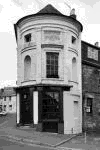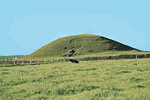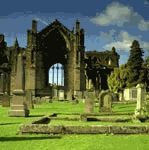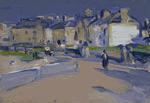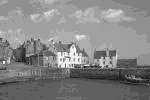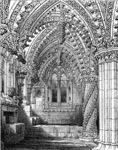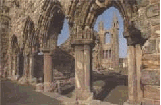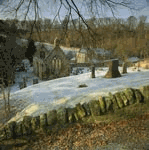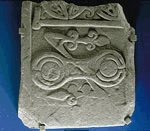|
Travel Mysterious Scotland - page 3
Kempock, Strathclyde (Standing Stone)
The 2 metres high 'Granny Kempock Stone' was once called the 'Longstone' and according to the trial records of Marie Lamont who was burned as a witch in 1662, witches danced round the Longstone at their sabbat intending to throw stone into the Clyde estuary to destroy ships. Presumably the attempt was unsuccessful as the Longstone is still in its original position.
Kinross, Tayside (Haunting, Demons)
Just outside Kinross is the stone circle known as the Orwell Stones.
Outside the council offices in Kinross itself is an impressive fountain complete with 4 carved demons. The priest's house in Kinross was the subject of a poltergeist attack in 1781. Pins were hidden in food, clothes were torn, stones were thrown and the preacher's bible was thrown onto the fire but did not burn.
Kirkcudbright, Dumfries and Galloway (Witchcraft)
Elspeth McEwen and Mary Millar were charged with witchcraft in Kirkcudbright in 1698. The horse on which McEwen was taken to trial is reported to have 'trembled and sweated blood'. She was strangled and burned at Kirkcudbright.
Lanark, Strathclyde (Witchcraft)
At the High Kirk at Lanark, Margaret Watsone confessed under the usual extreme torture that at a sabbat she had ridden on a bail of straw while her accomplices Mailie Paittersone, Janet Lockie, Jeane Lauchlan and her aunt Margaret had ridden on a cat, a cock, an elder tree and and a thorn tree respectively.
Maeshowe, Orkney (Burial Chamber)
The burial chamber at Maeshowe is illuminated by the sun at mid-winter which lights up the inner chamber 12 metres inside the mound. It has a number of Viking runic inscriptions and the Maeshowe dragon on one of the uprights.
Melrose, Borders (Wizard)
Melrose Abbey contains the tomb of Michael Scot, a 13th century wizard. He is alleged to have made a brass head that could talk and predict the future. Michael Scot instructed Frederick II of Italy in Arabian magic and astrology and also wrote the first book on astrology in Europe - the Introductorius.
North Berwick, Lothian (Witchcraft)
The witches of North Berwick are the most famous in Scottish history. They were supposed to have attempted to raise a storm to wreck the ship in which King James VI was returning from Denmark. According to contemporary reports, the Devil preached to the witches from the pulpit of the Old Kirk in North Berwick.
Pittenweem, Fife (Witchcraft)
A number of local women were charged with afflicting a man with a fit. Following torture at the hands of their guards they confessed to deeds of witchcraft. One of the women managed to escape her captors but was caught by the villagers, taken down to the beach and hung on a rope between the shore and a ship. She was then "pushed under a heavy door, over which stones were heaped until she was crushed to death. The murderers were never punished."
Prestonpans, Lothian
Local Prestonpans schoolteacher was tried for trying to bewitch a woman into his bed. He confessed to witchcraft after being tortured by 'the boot'. this was a metal boot which was placed on the suspected witch's foot and then smashed with a sledgehammer. He later withdrew his confession and despite having his fingernails pulled off and needles pushed into his fingers up to their heads and having the boot re-applied until his legs were completely crushed and "the blood and marrow spouted forth", he refused to confess again. The torturers decided that his strength was being provided by the Devil and took him for execution in Edinburgh.
Rackwick, Orkney (Dwarfie Stane Burial Chamber)
The 'Dwarfie Stane' on the island of Hoy is one of only 2 rock-cut burial chambers in the British Isles. Ireland has the other at Glendalough. The name Dwarfie Stane is from Sir Walter Scott's book The Pirate.
Rosslyn, Lothian (Gargoyles)
The famous Apprentice Pillar in Rosslyn Chapel - the church of St Matthew at Rosslyn (privately owned by the Earls of Rosslyn) is the pillar of Sir William St Clair, Prince of Orkney. Both inside and outside the church is a collection of gargoyles, demons and other grotesque figures and the roof has a number of pentagram stars similar to some found within Egyptian pyramids.
St Andrews, Fife (Witchcraft)
St Andrews was the site of many witch burnings both on Witch Hill which lies east of St Andrews and in Market Square. Step Rock in St Andrews Bay where suspected witches were 'swum' was used as a swimming pool until 1978. The witch swimmings that took place there involved the right thumb bring tied to the left big toe and vice versa before the suspected witch was 'swum'. A nearby knoll called Methven's Tower was believed to be a fairy hill but this did not stop witches from being burned on it. A storm in 1856 washed away some of the hill and exposed many human remains and a stake. The tortured face high on the wall of the tower of St Salvator's College (pictured above) is said to have formed as Patrick Hamilton, a Protestant martyr was being burned in front of the college in the 16th century.
Samuelston, Lothian (Witchcraft)
A number of witch trials and subsequent executions were held in Samuelston (the executions were at nearby Birlie Knowe).
Scotlandwell, Fife (Holy Well)
The holy well in Scotlandwell is one of the most beautiful of Scotland's holy wells. The waters bubble up into a cistern and can be drunk from a cup hanging by the well. The well itself is protected by a wooden roof. Robert the Bruce is said to have been cured of leprosy by drinking from the well.
Skirling, Borders (Dragons)
The village of Skirling is known for its collection of ornamental ironwork sculpture commissioned by Lord Carmichael. It shows Carmichael's oriental influence in its birds, dragons and lizards (Lord Carmichael was once Governor of Bengal).
Spott, Lothian (Witchcraft)
Spott village has a holy well which can still be seen although now dry. It was once the focal point of an annual St John's Day procession by the Knights Templar. In the 17th-18th centuries witches were burned at Spott Loan. A witch stone set back from the road matks the spot of a witch burning.
Staffa, Strathclyde (Giants)
It was believed that the hexagonal paves and basalt pillars of the island of Staffa had been carved by giants. Helena Blavatsky believed that parts of the Scottish Highlands are the last remnants of the islands that were left after Atlantis was swallowed by the ocean. Perhaps the myths of giants are distant folk memories of the atlanteans and the giants (Gibborim) spoken of in the Bible.
St Vigeans, Tayside (Pictish Stones)
Opposite the church in St Vigeans is a small museum containing a collection of 9th century Pictish stones. The 2 metres high Drosten Stone is decorated with a serpent, dragon, a hunting scene and a cross.
Storr, Isle of Skye (Legend)
Baldor of the Evil Eye is said to have turned an old man and his wife into stone to form the stack known as the Old Man of Storr on the Trotternish peninsula of the Isle of Skye.
Sunhoney Circle, Grampian (Stone Circle)
Sunhoney Circle is a stone circle hidden on private land within a distictive circle of trees just north of Echt village. Sunhoney is one of the 'recumbent circles' found in Scotland. There is a circle of 11 standing stones about 2.5 metres tall. The 6 metres long recumbent stone (which is said to be aligned towards minimum full midsummer moon) touches one of the stones on the south side. On the Sunhoney recumbent stone are 28 cupmarks, the purpose of which is unknown.
Temple, Lothian (Knights Templar)
The village of Temple was, as you might expect from the name, once associated with the Knights Templar. The small ruins of the 13th century church in Temple shows visible signs of the link with the Knights Templar - many of the memorials and gravestones feature secret symbols.
Tomnahurich Hill, Highland (Fairies)
According to common belief the thickly wooded and mysterious Tomnahurich Hill is where Queen Nicniven and the fairies hold court. One legend tells of a man who fell asleep on Tomnahurich Hill being invited to play the fiddle for a fairy party. He was taken to an underground palace and played until he could carry on no longer. He called out to God and was transported to a riverbank near his home. Then he realised that during the night with the fairies, 100 years had passed in the human world. He died soon afterwards and his grave is said to be in St Mary's Church in Inverness. The sorcerer Coinneach Odhar correctly predicted that the Fairy Hill of Tomnahurich would one day become a graveyard.
Tranent, Lothian (Witchcraft)
The events leading to the famous North Berwick witch trials started in Tranent. David Seaton was Deputy Bailiff of Tranent and he was suspicious of the healing powers of his servant girl Geillis Duncan which he attributed to the Devil. Abusing his position of authority he tortured the young girl until she admitted a pact with the Devil. After more torture at the hands of the judiciary, she named her supposed associates including Agnes Sampson.
Home Page
|
|

